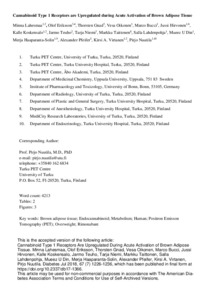Cannabinoid Type 1 Receptors Are Upregulated During Acute Activation of Brown Adipose Tissue
Alexander Pfeifer; Vesa Oikonen; Pirjo Nuutila; Kalle Koskensalo; Merja Haaparanta-Solin; Minna Lahesmaa; Jarmo Teuho; Jussi Hirvonen; Thorsten Gnad; Salla Lahdenpohja; Marco Bucci; Tarja Niemi; Markku Taittonen; Olof Eriksson; Kirsi A. Virtanen; Mueez U Din
Cannabinoid Type 1 Receptors Are Upregulated During Acute Activation of Brown Adipose Tissue
Alexander Pfeifer
Vesa Oikonen
Pirjo Nuutila
Kalle Koskensalo
Merja Haaparanta-Solin
Minna Lahesmaa
Jarmo Teuho
Jussi Hirvonen
Thorsten Gnad
Salla Lahdenpohja
Marco Bucci
Tarja Niemi
Markku Taittonen
Olof Eriksson
Kirsi A. Virtanen
Mueez U Din
AMER DIABETES ASSOC
Julkaisun pysyvä osoite on:
https://urn.fi/URN:NBN:fi-fe2021042719406
https://urn.fi/URN:NBN:fi-fe2021042719406
Tiivistelmä
Activating brown adipose tissue (BAT) could provide a potential approach for the treatment of obesity and metabolic disease in humans. Obesity is associated with upregulation of the endocannabinoid system, and blocking the cannabinoid type 1 receptor (CB1R) has been shown to cause weight loss and to decrease cardiometabolic risk factors. These effects may be mediated partly via increased BAT metabolism, since there is evidence that CB1R antagonism activates BAT in rodents. To investigate the significance of CB1R in BAT function, we quantified the density of CB1R in human and rodent BAT using the positron emission tomography radioligand [F-18]FMPEP-d(2) and measured BAT activation in parallel with the glucose analog [F-18]fluorodeoxyglucose. Activation by cold exposure markedly increased CB1R density and glucose uptake in the BAT of lean men. Similarly, 3-receptor agonism increased CB1R density in the BAT of rats. In contrast, overweight men with reduced BAT activity exhibited decreased CB1R in BAT, reflecting impaired endocannabinoid regulation. Image-guided biopsies confirmed CB1R mRNA expression in human BAT. Furthermore, CB1R blockade increased glucose uptake and lipolysis of brown adipocytes. Our results highlight that CB1Rs are significant for human BAT activity, and the CB1Rs provide a novel therapeutic target for BAT activation in humans.
Kokoelmat
- Rinnakkaistallenteet [19207]
